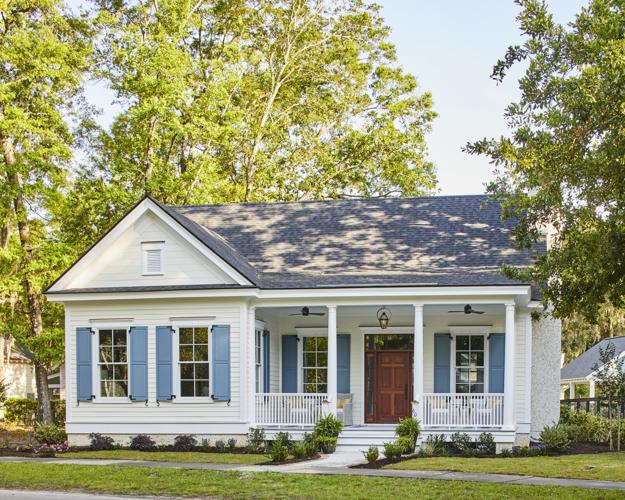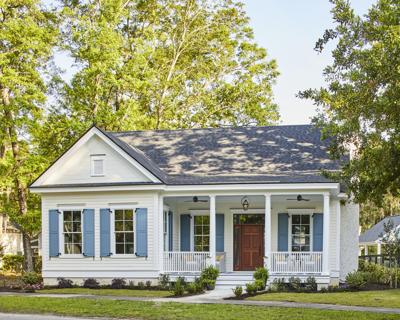BEAUFORT — For people with Parkinson's, sleep can be an issue.
Scott Rider, who was diagnosed with the disease 16 years ago, found he often woke up around 3 a.m. — and usually with an idea.
"I'm full of lots of ideas," he said. He tried to jot them down in a notebook beside his bed.
The trouble is, penmanship can also be an issue for people with Parkinson's. Writing by hand is one of many everyday activities affected as the body becomes stiffer, shakier and slower.
By the next morning, when Rider studied his notebook, he couldn't always figure out what he had written.
But in late 2020, one of his middle-of-the-night ideas stuck.
It was about the place where he and his wife live. Habersham is a planned community 7 miles from downtown Beaufort, currently with about 400 homes. It is designed to look and feel like a small Southern town, the kind of place where people grow up, raise families and stay into old age.
Several magazines had already created floor plans for Habersham houses.
"There has been a Coastal Living house, there has been a Southern Living house, and I thought, gosh, we should make an adaptive house!" Rider said. In his notebook, he captured his vision for a home allowing someone with physical limitations to live more independently.

The side tables have a flat surface that can be pulled out for easy middle-of-the-night writing. Southern Living/Provided
The home is now real.
"The adaptive cottage" opened for tours in June and will be featured in the August edition of Southern Living magazine. Proceeds from the sale of the floor plans and the house itself will be donated to the Parkinson's Foundation.
It is designed to bridge the gap between an ordinary house and one fully compliant with the American with Disabilities Act. Like a person, it is expected to change.
60 Mount Grace
The one-story house blends in with the other houses on the street, called Mount Grace.
Its location near a commercial area is one of its most important virtues, said Eric Moser, who donated his residential design services to the project.
Normally, people with limited mobility spend a lot of time waiting for someone to pick them up in a car. But in a denser setting with wide sidewalks, they can take themselves to the dentist or the barber, either on foot or in a wheelchair.

The faucets in the bathroom do not require turning a knob. Southern Living/Provided
To get in and out of the house, a ramp can be installed over the shallow stairs. Throughout the interior, the doors and hallways are wide enough to accommodate a walker or wheelchair.
In addition, wooden beams behind the drywall make installing hand railings easy.
And pocket doors, levers instead of knobs, and outlets placed mid-wall reduce the need for fine motor control or good balance.
Build for cohabitation, ease
These features are easy enough to include in new construction, Moser said. What's less obvious to most builders and designers is a flexible layout.
The vast majority of the housing stock in the U.S. is built for a nuclear family, he said. But in reality, only about 20 percent of American households today are comprised of minor children and two adult parents.
Letisha Scotland, the director of aging for the Lowcountry Council of Governments, said her clients show how people of all ages and life stages are living together. Sometimes older people move in to help care for younger ones; sometimes younger people move in to help care for older ones.
But in the current economy, Scotland said, more people are cohabiting, whether they're related or not. Soaring rental and mortgage rates are forcing more individuals into a single family unit.
In response to the realities of today's households, Moser designed the adaptive cottage with two master bedrooms. Each has a private bathroom, walk-in closet and separate entrance.

A third room, currently set up as a guest room, has a built-in space for a wall bed if it needs to double as an office, exercise room, or den. Southern Living/Provided
A third room can be used as an office, den, exercise studio, or guest room — or some combination.
Allan Patterson, who constructed the house and then gave the profit to the Parkinson's Foundation, doesn't believe in wasted space, especially for people seeking to age in place. He prefers fewer rooms that can serve multiple purposes.
"As you get older, you don't want to be working on your house all the time," he said.
Technology matters a lot
Moser noted that smaller houses also cost less, both upfront and over time. "And that gives us the latitude to do cool things," he said.
One is investing in an oven that can be monitored from a smartphone.

The stove, donated by GE, can be updated automatically with new features, like a phone can. One of the newest ones: a setting to cook a perfect steak. Southern Living/Provided
For Rider, that technology matters not only because it reduces the occasions he has to maneuver into the kitchen and open the oven door. It also fits with the rhythm of his days.
"Life is made possible when you have Parkinson's through medication, and medication has a cycle," he said.
After taking it, he feels great. "You almost forget you have Parkinson's, everything's working good," he explained. And then gradually, the effects start to wear off.
As a result, Rider could do something like make cookies or stuff a turkey when he had the energy, pop them in the oven, and then sit down. As they cooked and he became depleted, he wouldn't have to get out of his chair to check on them — he could simply watch from his screen. When they were done, he could push a button to turn off the heat.
"It's just amazing," Rider said.
At the agency on aging, Scotland noted that most of her clients can't afford a cutting-edge oven right now. However, technology is still a game changer, she said. It can make small interventions that will ultimately save lives and extend the time people can remain in their own homes.
For example, security systems can alert caregivers if someone with Alzheimer's leaves the house. A programmable thermostat is a great idea, too, she said.
One innovation Scotland would like to see: a smart microwave. She recalled her grandmother, who suffered from dementia, nuked food for hours at a time. "I hope you wouldn't be able to do that in the future," Scotland said.
Open a door
On Hilton Head, Debi Lynes is an interior decorator with a doctorate in psychology. She specializes in creating places with health and wellness in mind.
A few years ago, her 90-something father moved in with her, and her daughter had a baby.
"Aging in place is really for any stage of life," she said.

For safety, Debi Lynes simply removed the oven when her father moved in. She also raised the dishwasher a few inches to make loading it easier. Kelly Jean Kelly/Staff
For example, many of the adjustments for a wheelchair — such as a dining room table with a center column instead of legs – also work for a high chair.
And what she calls "wayfinding" — deliberately setting up lighting to create a path – is useful for people who need to use the bathroom in the middle of the night, comfort a child, or, like Rider, pass the time before going back to bed.
Safety and security are the most important things, she stressed, noting the need for a well-marked entrance in case medics needs to come.
But her language kept drifting to feelings.
Her dad didn't use a wheelchair at home because of "pride," she said. Instead, they created handholds for him throughout the house, sometimes just using stick-on devices they bought for $14 at Home Depot.
An inexpensive folding screen in front of the toilet preserved his dignity, as did a bench in the bathroom and a handheld shower. A specially designed toilet paper holder and towel racks doubled as bars he could use to hoist himself up without calling attention to his difficulty standing.

Debi Lynes installed blinds that could be open from the top or bottom, giving her dad more control over the light. Kelly Jean Kelly/Staff
Rider also spoke fondly of adaptive products that looked like everyone else's.
"Parkinson's takes away so much of your life as it is," he said. "So to be able to have independence and be able to put your shirt on without having to ask for help, to be able to put your shoes on without having to ask for help, that's a good feeling."
When asked what her aging clients needed most, Scotland said, "Having people to talk to."
Lynes expressed the same idea. As she showed the DIY adjustments she and her husband had made to their home for her dad — labels on switches, a raised bed, an air fryer instead of a range — she glanced back at the front door.
They usually kept it open, she said. It let in the natural light, which is important because the brain's dopamine production declines with age and disease.
But it also let in the neighbors. Her dad liked to see who was coming and going, and he always appreciated them stopping to chat, even if they only paused to say hello.


















